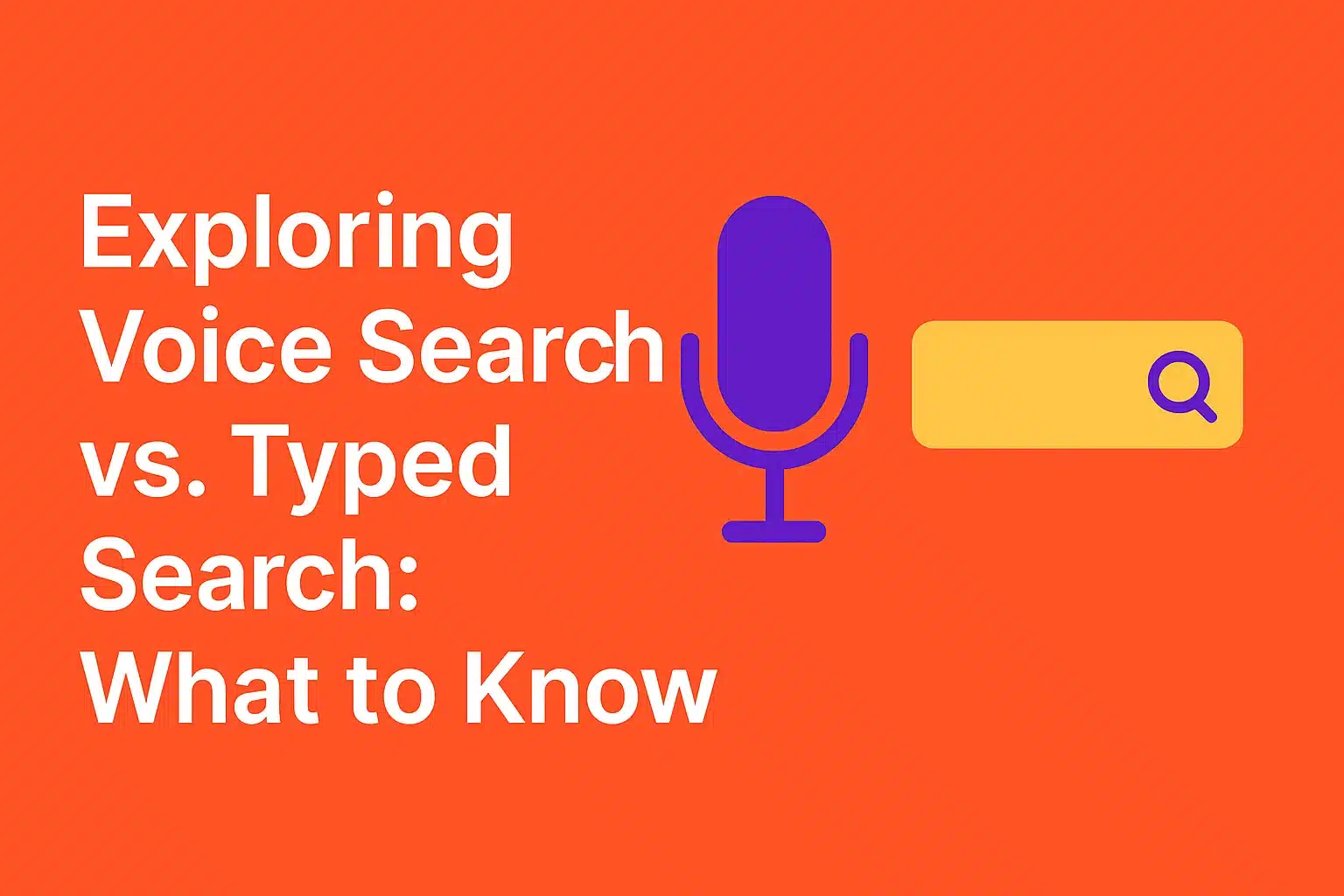Voice search has changed how adults query information on the internet. Today, many simply press a button or say a voice command rather than typing. This shift has impacts for online businesses and day-to-day directions. Everyone, from busy office workers to casual shoppers, sees the appeal of convenient, hands-free use. Still, typed searches continue to hold important value. By exploring the basics of both methods and focusing on voice search optimization, people better understand what each approach offers and why it matters.
Both voice and typed queries have distinct advantages for different users. Some people prefer quick voice commands to find local spots or handle instant tasks. Others type advanced keywords or specific settings to refine their results. Understanding the nuances of each style shows how content creators and businesses can adapt, making sure they reach a wider variety of people seeking accurate or natural answers.
Understanding Voice Search vs Typed Search
Voice search vs typed search shows how users differ in their use. Many choose spoken prompts when they need to multitask, while typed input remains crucial for deeper inquiries. Content creators can use voice search optimization to answer extended questions, while typed queries help find exact terms. Voice use often feels more relaxed, while typed inquiries let people refine finer details. By understanding these differences, brands can organize their content well. Doing so helps businesses stay visible on devices that support different input settings and contexts.
Key behavior differences in how users search
Speech-based queries often include full questions, such as “Where can I find coffee nearby?” On the other hand, typed inputs rely on short keywords like “coffee shops near me.” Voice-led inquiries feel more natural, matching everyday language habits. This shift leads to longer phrases and increased attention on instant or local information. Typed queries usually involve brief phrasing, with users scanning through a list of options. Knowing these behavior patterns allows marketers and site owners to satisfy user needs in both formats.
Search result format changes with voice input
Text-based searches are often brief, while voiced queries tend to be longer, again matching natural speech. According to Flowster, voice searches also rely on factors like user intent and location to provide speedy answers [Flowster]. Featured snippets commonly appear at the top, acting as instant responses for hands-free needs. Mobile devices and smart speakers favor these brief, spoken replies. This setup shifts the way sites organize their content, focusing on clear, context-based details. Local SEO thus becomes even more important.
When do users prefer typing over speaking
People sometimes switch to typed input when they want privacy or face noisy background noise. They often avoid speaking out loud in libraries, offices, or crowded places. Detailed or private searches might feel awkward in public, making typed questions far more private. Some also prefer typing for complex topics involving data or technical details. Even with voice prompts getting more popular, certain situations still favor quieter, more private tasks. This pattern shows that both approaches remain important in a variety of speaking situations.
Explaining How Voice Search Works
Voice search changes verbal requests into text through specific algorithms. First, a device listens for a wake phrase or a button prompt. It then records the audio, which is sent for speech-to-text processing. Advanced platforms understand the user’s context—like location or search history—to improve the output. Often, this system uses cloud-based servers for quicker machine learning and higher accuracy. By investing in voice search optimization, companies match their sites with the everyday language queries people speak.
Stages involved in voice recognition
Voice recognition begins with recording audio and changing analog sound into digital form. That data is then examined using methods like hidden Markov models or neural networks. According to TechTarget, software checks these inputs against a stored word list [TechTarget]. The system matches phonemes and words to produce text or commands. Processing speed and algorithmic approaches influence how accurate the results can be. Coders improve processes for different accents, leading to more strong performance over time. Filtering out background noise further affects the outcome, while frequent updates keep accuracy.
Role of natural language in interpreting queries
Natural language processing (NLP) helps systems understand spoken requests in ways that match everyday speech. Convin Blog notes that NLP automation lets voice bots handle multiple tasks at the same time, increasing overall speed [Convin Blog]. By understanding nuances in accent, emotion, and context, NLP improves query outputs. Multilingual versions also increase reach, allowing easy support across different regions. This technique personalizes the user experience, reducing reliance on manual help. Enhanced understanding often leads to higher customer satisfaction, and numerous studies show significant accuracy improvements.
Devices and platforms supporting voice search
Voice-enabled hardware includes smartphones, smart speakers, and in-car systems. Newman Web Solutions highlights how Automatic Speech Recognition changes verbal input into text through machine learning ([Newman Web Solutions]. Well-known assistants—such as Siri, Google Assistant, and Alexa—work with these devices, handling everything from directions to local shop listings. Many people prefer voice prompts because they offer quick, easy use. As customizing advances, systems further improve the quality of results, customizing answers to each person’s specific likes or location data. This model enables greater ease of use overall.
How Does Voice Search Affect Your SEO?
Voice search affects SEO by favoring more natural requests. Sites need to include brief, direct answers to typical questions, which often appear as featured snippets. Doing so helps them rank in voice assistants’ results. Local searches also become more important, because many users request services nearby while they travel. Marketers should use long-tail keywords and natural language to match spoken queries. By handling these changes, businesses improve their visibility in a voice-oriented online space. This approach ultimately improves overall position.
Basics of Speech Recognition Technology
Speech recognition technology involves the process of changing spoken words into written text. It relies on acoustic models, language models, and specialized speaking dictionaries. These systems connect vocal patterns to words with help from advanced machine learning. Many current platforms adjust to multiple accents or changing noise levels, thus improving overall accuracy. This field has progressed greatly due to large data sets and progress in neural networks. Businesses incorporate these solutions across apps, virtual assistants, or call centers to offer hands-free usage. Such approaches increase overall ease of use.
Core components of speech recognition systems
Basic elements include speech input, analysis, a decoder, and the final output. According to IBM, speech recognition uses grammar, syntax, and structure to process human speech [IBM]. Acoustic models process audio signals, while language models forecast how words go together. A speaking dictionary connects phonemes to words, allowing the system to match sounds accurately. Memory capacity influences the size of a system’s word list, so powerful hardware handles larger lists. By adapting these components, developers process specific jargon more effectively and improve transcription speeds. At the same time, effective decoders decrease lag in processing.
Improvements in accuracy over time
Early speech systems could only recognize a small word list. Over the years, neural networks and large data sets reduced error rates lower. audEERING notes that some providers have seen accuracy rise to approximately 96% [audEERING]. Continuous improvement of acoustic models and more advanced neural methods improved how these systems handle different accents. OpenAI’s comprehensive training also increased overall accuracy. These advances helped voice assistants understand user requests with fewer mistakes, thus improving trust and accelerating adoption. Currently, modern updates train on millions of examples.
Top companies leading in voice tech research
The global speech recognition market may reach US$30 billion by 2026, reports AI Magazine [AI Magazine]. Firms such as iFLYTEK and Sensory develop multilingual skills, while Mobvoi handles consumer electronics and commercial uses. Microsoft’s purchase of Nuance helped healthcare transcriptions. Additionally, Speechmatics competes across different accents, showing high accuracy. Amazon Transcribe and Alexa offer wide usage. These innovators focus on improving language models to handle varied dialects and contexts, expanding speech solutions into more devices and industries. They ultimately support continued progress.
Voice-driven queries and typed searches both fulfill important functions for today’s internet users. Voice prompts depend on speech recognition technology, which has improved greatly to match different accents and usage situations. Many people find speaking quicker for immediate questions, while typing is helpful for more private or complex inquiries. As machine learning algorithms continuously improve their accuracy, voice assistants become part of daily routines. Marketers and publishers should use voice search optimization methods by focusing on local elements, natural language, and brief content. By enabling both forms of input, businesses can offer adaptable choices for different user likes and stay accessible on different platforms. Such ability to change improves overall brand engagement.
FAQs
For those looking for more details about voice-driven queries, these answers answer common questions about accuracy, local advantages, and upcoming trends. Review them to learn more about this quickly changing domain.
What is the most accurate voice search platform today?
How does voice search optimization differ from traditional SEO?
Is voice search better for local SEO?
How quickly is speech recognition technology advancing?
How do voice assistants handle similar search queries differently?
What trends show the future of voice search usage?

Ridam Khare is an SEO strategist with 7+ years of experience specializing in AI-driven content creation. He helps businesses scale high-quality blogs that rank, engage, and convert.



